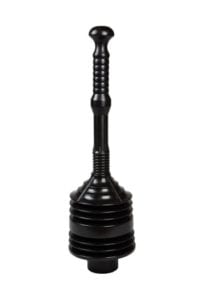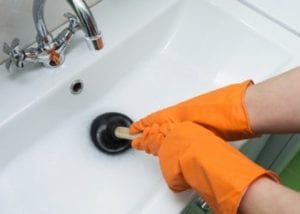
14 Aug How To Use A Plunger Properly
How To Use A Plunger Properly
Today, your friends here at Benjamin Franklin Plumbers are going to teach you how to use a plunger. Although it may seem like a no-brainer, there is a specific refined technique for people who think they know a thing or two about how to use a plunger. We often hear stories of customers who failed to unclog drains because they didn’t know how to use a plunger, so it only makes sense to publish information that is as detailed as possible.
Types of Plungers
Like any job, having the right tools makes things a whole lot easier. When it comes to plumbing, there is more than one type of plunger to unclog a drain. There are three major classes of plungers that each have distinctive qualities.
Cup Plungers
You probably recognize the simple cup plunger. This tool is made of rubber and shaped into a simple bowl or cup shape. These plungers are useful for popping soft dents out of cars, cleaning clogs out of sinks, and are most effective for drains that are somewhat backed up with food or grease clogs. Hair clogs usually require a snake because hair is almost as tough as steel and doesn’t become dislodged very quickly once it builds up into thick hairballs.
Flange Plungers
Flange Plungers look like cup plungers but then have a narrowing flange lip that extends below the rubber cup. These plungers are ideally suited for unclogging toilets and severe drains. The flange sits inside the pipe to form a tighter seal. The larger size of the rubber cup provides more gumption force to dislodge serious clogs.
Bellows Plungers
These accordion-style plungers provide the maximum pressure to unclog even the toughest drain clogs. The only drawback is that these plungers consist of plastic rather than rubber, which can scratch delicate surfaces. In any case, if a bellows plunger won’t open up your clog, you’ll probably need a snake, new pipes, or chemicals to treat it.
How to Use a Plunger Effectively
When it comes to putting your plunger to work, the methods used are essential. It usually helps to put some petroleum jelly on the lip of a clean plunger to form a tighter seal. Applying petroleum jelly will also preserve rubber plunger cups and help them to last longer.
The force of the plunger will expel some water and raise the water level in the toilet or sink; you should remove the water carefully now if you don’t want it all over your floors.
Therefore, it would be wise to remove any excess water with a bowl and to seal any drains that are on the same downpipe. You may have a dual sink that drains into the same plumbing. If you don’t use a wet rag or something to seal the other side, you will not be able to build up sufficient pressure on the side that is clogged.
You should perpendicularly use quick thrusts. You want to work straight at the drain without maneuvering the handle in different directions. You will be able to feel if you have the right technique because the plunger cup will deform and seamlessly thrust water pressure directly into the drain. It will have a suitable action mechanism that builds momentum.
You may have to burp the plunger to let the excess trapped air out. If the cup is air-locked, it won’t be instrumental in using water pressure to jar the clog loose. Tilt the plunger once it is under the water to ensure that no air is trapped.
No matter what happens, you should never give up after a few tries. Some clogs can be tough to lodge loose but will eventually come if you put enough thrusts and pressure on them.
Storing Your Plunger
When you are done using your plunger, you should always wash it thoroughly but avoid using chemical cleaners. Pure soap and water or even an antibacterial soap are sufficient to ensure that bacteria is not growing on the surfaces.
Any water that you will use your plunger on will be considered gray or black water. This water can make you sick, and you certainly wouldn’t want in your food or drinks. And, as stated, you can even coat the rubber cup with petroleum jelly after it dries. Most plungers come with a little tray to store them in under the sink or in the bathroom.
Practice Plunging
If you want to practice, you don’t need a clogged drain. You can practice in a toilet at any time because there is always enough water standing to create pressure. You won’t damage the toilet because you are simply flushing it down without using gravity-fed water pressure.
You may not even know that your drains are starting to clog. It can take a long time for a drain to clog up and back up your water entirely. Bathroom tubs are notorious for slow clogs because the soap residue and hair can extend deep into the pipes without clogging them up completely.
Since drains can clog slowly, you may even decide to fill up your sinks and tubs slightly to help flush the drain pipes every so often. Taking this step is a form of preventative maintenance that can save you from having to wrestle with a severe clog down the line.
Conclusion
Knowing how to use a plunger is half the battle. Practicing how to use a plunger and confidently demonstrating the skill to use a plunger is the other half of the fight. And if your drains still get clogged up, do not hesitate to call your friends at Benjamin Franklin Plumbers for the affordable first-class service you deserve.
Benjamin Franklin Plumbing Tyler serves the East Texas cities of Kilgore, Longview, Tyler, and Whitehouse with a team of certified plumbers. In addition to emergency plumbing repair, some of the plumbing services provided by the company include faucet repair, drain services, toilet repair, plumbing fixture installations, tub and shower installations, kitchen sink repair, faucet installation, water heater repair/replacement, and garbage disposal replacement. Call us today at (903) 730-6611 to schedule an appointment!

